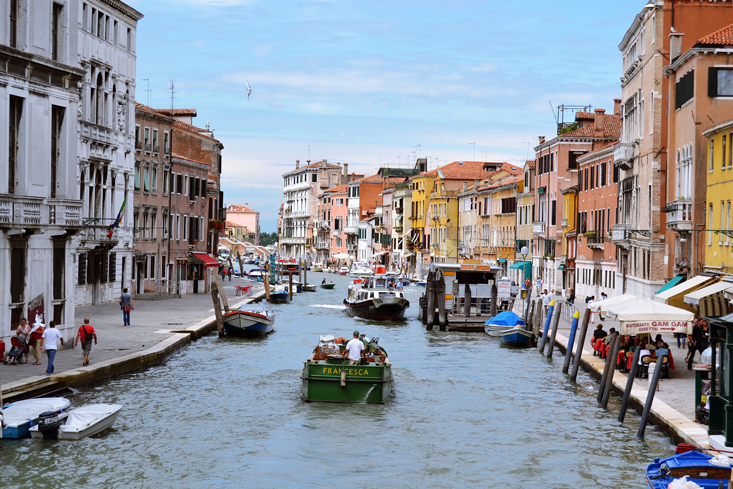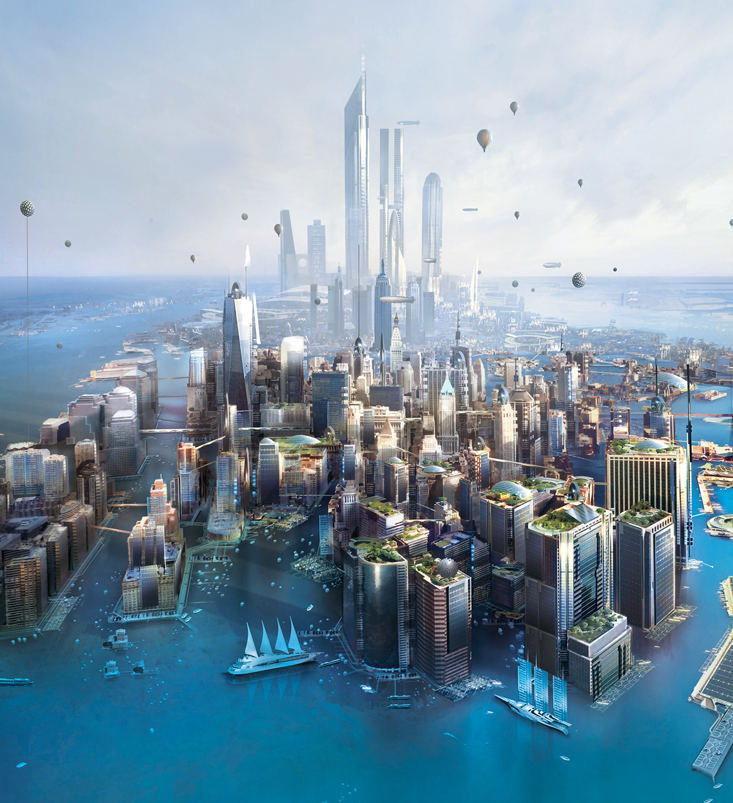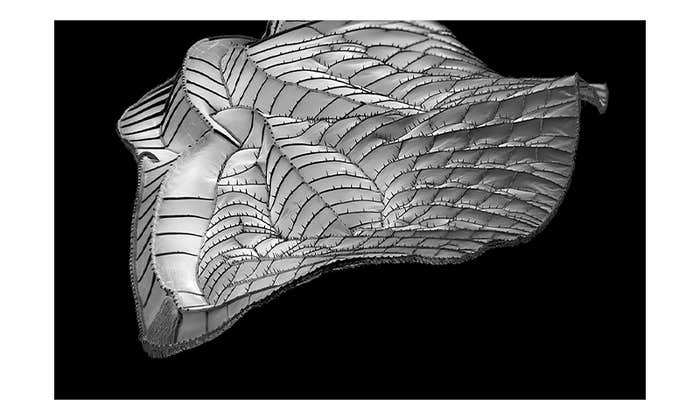Science-fiction author Kim Stanley Robinson paints a vivid picture of life in New York City after the sea level rises more than 50 feet, drowning lower Manhattan and creating a forest of skyscrapers in his new book, New York 2140.
1
Numbers often fill my head. While waiting for my building’s morose super to free my Jesus bug from the boathouse rafters where it had spent the night, I was looking at the little waves lapping in the big doors and wondering if the Black-Scholes formula could frame their volatility. The canals were like a perpetual physics class’s wave-tank demonstration— backwash interference, the curve of a wave around a right angle, the spread of a wave through a gap, and so on—it was very suggestive as to how liquidity worked in finance as well.
Too much time to give to this question, the super being so sullen and slow. New York parking! One can do nothing but practice patience. Eventually the zoomer was mine to step into, off the boathouse dock and then out the doorway onto the shadowed surface of the Madison Square bacino. Nice day, crisp and clear, sunlight pouring down the building canyons from the east.
As on most weekdays, I hummed the bug east on Twenty-third into the East River. It would have been shorter to burble south through the city canals, but even just past dawn the southward traffic on Park was terrible, and would only get worse at the Union Square bacino. Besides I wanted to fly a little before settling in to work, I wanted to see the river shine.
I turned and thwopped across some big barge wakes, then hummed and gurgled into the city.
The East River too was busy with its usual morning traffic, but there was still room in the fast southbound lane to plane up onto the Jesus bug’s curving hydrofoils and fly. As always the lift off the water was exhilarating, a rise like a seaplane taking off, some kind of nautical hard-on, after which the boat flew over its magic carpet of air some six feet off the river, with only the two streamlined composite foils shearing through the water below, flexing constantly to maximize lift and stability. A genius of a boat, zooming downriver in the autobahn lane, ripping through the sun-battered wakes of the slowpokes, rip rip rip, man on a mission here, out of my way little bargie, got to get to work and make my daily bread.

If the gods allow. I could take losses, could get shaved, get hosed, take a hammering, blow up—so many ways to say it!—although all were unlikely in my case, being well hedged and risk averse as I am, at least compared to many traders out there. But the risks are real, the volatility volatile; in fact it’s the volatility that can’t be factored into the partial differential equations in the Black-Scholes family, even when you shift them around to account for that quality in particular. It’s what people bet on, in the end. Not whether an asset price will go up or down—traders win either way—but just how volatile the price will be.
All too soon my jaunt downriver got me offshore of Pine Canal, and I cut back on the jet and the bug plopped down into ordinary boathood, not like a goose crashing down, as in some hydrofoils, but gracefully, with nary a splash. After that I turned and thwopped across some big barge wakes, then hummed and gurgled into the city, moving at about the pace of the breaststrokers braving the toxicity in their daily suicide salute to the sun. The Pine Canal Seebad was weirdly popular, and they did indeed “see bad,” pods of old breaststrokers in full wetsuits and face masks, hoping the benefits of the aquatic exercise and the flotation itself counteracted the stew of heavy metals they inevitably took on. Got to admire the aqualove of anyone willing to get into the water anywhere in the greater New York harbor region, and yet of course people still did it, because people swim in their ideas. A great attribute of the species when it comes to trading with them.
The hedge fund I work for, WaterPrice, had its New York offices occupying all of the Pine Tower at Water and Pine. The building’s waterbarn was four stories tall, the big old atrium now filled with watercraft of all types, hanging like model boats in a child’s bedroom. A pleasure to see the foils curving under my trimaran’s hulls as it was hoisted into place for the day. A nice perk, boathouse parking, if expensive. Then up the elevator to the thirtieth floor and over to the northwest corner, where I settled into my aerie, looking through a scattering of skybridges midtown, and the superscrapers looming uptown in all their gehryglory.
2
The intertidal zone of lower midtown sloshed back and forth over an area with a lot of old landfill, and that double whammy had brought a lot of buildings down. Thirtieth to Canal was a wilderness of slumped, tilted, cracked, and collapsed blocks. A house built on sand cannot stand.
Nevertheless I saw the usual signs of squatting in the soggy ruins. Life there possibly resembled earlier centuries of cheap squalid tenement reality, moldier than ever, the occupants risking their lives by the hour. Same as ever, but wetter. But even in the worst neighborhoods there stood some islands of success, waterproofed and pumped out and made habitable again, in many cases better than ever, or so people claimed. The mutual aid societies were making something interesting, the so-called SuperVenice, fashionably hip, artistic, sexy, a new urban legend. Some people were happy to live on the water if it was conceptualized as Venetian, enduring the mold and hassle to live in a work of art. I liked it myself.
As always, each neighborhood was a little world, with a particular character. Some of them looked fine, others were bedraggled, still others abandoned. It wasn’t always clear why any given neighborhood should look the way it did. Things happened, a building held or fell down, its surroundings followed. Very contingent, very volatile, very high risk.
Anyone who tried on a regular professional basis to fight the sea in any capacity whatsoever always admitted that the sea always won in the end.
So on this day I hummed in very slowly to have a look at the neighborhood, south of the recently-fallen tower. It was south of the Hudson Yards, I noticed, a small bay that had lost the railroad tracks that used to floor it, leaving the shallows there open to tidal tear so severe that it was said to be as deep there as in the middle of the river. Whether seepage from that hole in the side of the island had caused this tower to fall was unknown, but there it was, its broken upper half taking waves right in its broken windows. It looked like a crippled cruise ship on its last slide to the bottom.
A lot of other buildings were following it down. I was reminded of those photos of drunken forests in the Arctic, where melting permafrost had caused trees to tilt this way and that. Chelsea Houses, Penn South Houses, London Terrace Houses, they all canted drunkenly. Recovery techniques were improving all the time, but there is no point to waterproofing a house built on sand. The graphenated composites and diamond sheeting are strong but they can’t hold slumping concrete, they’re more like very strong plastic wrap; they need support to work, they’re mostly waterproofing.
As I purred along the narrow canals between Tenth and Eleventh I caught sight of the Great Intilt Quad, up near the shore of the Hudson. Here in the first rush of skybridge building a group of investors had suspended a mall about forty stories above the ground, in the middle of four skyscrapers that anchored the skybridges holding the mall in air. This had thrilled people until the weight of the mall had pulled the four towers abruptly inward, dropping the mall five stories at once and breaking everything in it before somehow the towers held. After that people had gotten a lot more careful, and now the Great Intilt Quad stood there like a bad Stonehenge, reminding people never to hang too much weight outside the plumb line of a skyscraper. They were only built to hold up their own weight, as many engineers pointed out.
All these drunken buildings: how long could they last? In the eternal battle of men against the sea, which antagonist was winning? The sea was always the same, while improvements were being made in humanity’s ramparts; but the sea was relentless. And it might rise yet again. A Third Pulse was not out of the question, although big masses of ice at risk of sliding were not currently being identified by the Antarctic surveys; this was a finding factored into the IPPI. Anyway, wherever sea level went in years to come, the intertidal was always going to be in trouble. Anyone who tried on a regular professional basis to fight the sea in any capacity whatsoever always admitted that the sea always won in the end, that its victory was merely a matter of time. Some of them could get quite philosophical about this in a depressive nihilist way. Nothing we do matters, we work like dogs and then we die, et cetera.
So a time was going to come when all the weaker buildings in the intertidal were going to need major repair—if that was even possible. If it wasn’t, they would have to be replaced—if that could even be done!
Meanwhile, people were living here. Signs of squatting were everywhere: broken windows replaced, laundry hanging from clotheslines, farms on rooftops. Especially by day it was obvious. At night they would turn off their lights and their buildings would look abandoned, perhaps here or there candlelit for their ghosts’ convenience. But by day it was easy to see. And of course it would always be that way. Manhattan never had enough places to live. And you couldn’t make rents high enough to keep people away, because they dodged the rents and squatted wherever they could. The drowned city had endless nooks and crannies, including of course diamond bubbles holding the tide out of aerated basements. People living like rats.
3
“Mayday,” the Met said from Vlade’s wall monitor. He had chosen a woman’s voice for the building, and now he found himself sitting up in bed reaching for the light and then his clothes. “What’s up?” he asked. “Report.”
“Water in the sub-basement.”
“Shit.” He leaped up and threw on his Carhartts.
The wetsuits and dive tanks and gear were in the boathouse, in a storage room next to his office. People were getting out in their watercraft without undue stress, it seemed, and Su nodded nervously to him that all was well. “I’m going to take a quick dive,” Vlade told him, which caused Su to frown. Dives were never supposed to be solo, but Vlade did it all the time around the building, accompanied only by a little sub sled.
“I’ll keep the phone on,” Su said, to remind him, and Vlade nodded and began the somewhat arduous process of getting his wetsuit on. For building inspections he could use the smallest tank, and the headset was just a mask settling onto the hood like a snorkel mask. The seal was not completely hermetic but good enough for brief work near the surface, and he could scrub down afterward.
Being underwater in one of the canals was about as ordinary to him as walking the streets uptown.
There were steps down into the water inside the boathouse. Only three were now exposed, which meant it was almost high tide. Down he went, feeling like the swamp thing from the eponymous movie, the scariest movie of all time in his opinion. Happily he was not dragging some poor rapidly aging maiden down with him. Nor even the sled, which was not needed for a dive like this.
The water was cold as always, even in the wetsuit, but he had been warming up so fast that it felt good to be cooled. Submerge, quick test of the gear, then out the boathouse door into the bacino, swimming horizontally. The wetsuit’s feet were just slightly webbed and finned, and that too felt good. Headlamp on, powerful beam, nevertheless mostly catching the particulates in the god-awful water of the city, as always. Actually the hundreds of millions of clams in the aquaculture cages all over the intertidal were doing yeoman work in filtering clean the water. Now he could usually see at least two or three meters, and sometimes more. Stay deep enough to not get knocked on the head by some boat’s keel or prop, but high enough not to run into the bacino’s aquaculture pens. The familiar weightlessness of neutral buoyancy, of horizontal underwater life. Lots of fish in the highest cages: salmon, sea trout, catfish, the sinuous schools of shy bodies all turning together against the cage sides.
Swim around the northwest corner of the building, hovering over the old sidewalk like a ghost. Sidewalk, curb, street: always a little stab of the uncanny to see these signs of New York as it used to be. Twenty-fourth Street.

Around the corner, float to the spot on the wall outside room B104. GPS to be sure he was there. He put his face to the wall and inspected the diamond sheen inch by inch, running his gloved fingers over it too. Nothing super obvious . . . ah yes, right outside the inner crack, it seemed: an outer crack. What the fuck?
Vlade had spent ten years in the city’s water division, working on sewage lines, utilidors, subway tunnels, and aquafarms, mostly. So being underwater in one of the canals was about as ordinary to him as walking the streets uptown, or indeed more ordinary, as he hardly ever went uptown. The surface overhead surged slightly back and forth like a breathing thing. Opalescent sheen to the east where the sun was rising between buildings. Wakes crisscrossing, slapping against the Met and North, rebounding and breaking against each other, bubbles coming into being and snapping out of existence. A glimpse of the sun now, shattering on the water when he looked east along Twenty-fourth. All normal; but still he found himself creeped out. Something was wrong.
Just to be sure, he swam to the building’s northeast corner and shined his headlamp at the juncture of building and sidewalk, looking five or six meters on both sides. This was always a weird sight, with the goo that sealed the juncture of building and ancient sidewalk looking like congealed gray lava, and the sidewalk itself diamond-sheeted, even to a certain extent the old street surface. This was the weak point for every building still upright in the shallows of lower Manhattan; you could only seal surfaces so far out from the building, and beyond that they were permeable. Indeed one of the projects of city services was to caisson and pump out every drowned street in the city, about two hundred miles of streets all told, and diamond sheet every surface up to above high tide, before letting the water back in. This could only ever be partly successful, as of course there was already water everywhere down there below street level, saturating the old concrete and asphalt and soil, so they would be sealing some of it in while keeping the rest out. It wasn’t clear to Vlade that this would be particularly useful. Closing the barn door after the horses had leaked, as far as Vlade and many other water rats were concerned, but the hydrologists had declared it would help the situation, and so slowly it got done. As if there weren’t more pressing chores on the list. But whatever. Looking at the edge of the sealant and sheeting and the beginning of bare street concrete, now a canal bottom, Vlade could feel in his gut why the hydrologists had wanted to try something. Anything.
Inspection complete, he swam slowly back into the boathouse and clomped dripping up the steps, this time reminding himself of the creature from the black lagoon.
When he was out of the wetsuit, and had sprayed down his face and neck with bleach, and washed that off and dried himself and gotten back in his civvies, he called his old friend Armando from Lame Ass’s submarine services. “Hey Mando, can you pop over and take a look at my building? I got a couple of leaks.” Mando agreed to schedule him in. “Thanks.”
He looked at the photos on his pad, then turned to his screens and called up the building’s leak records. Also, after some hesitation, the building’s security cameras.
Nothing obvious. But then again, after checking his log: there was nothing recorded on the basement cameras, even on days when people had definitely gone into those sub-basement rooms, as recorded in the logs.
Often after a dive he felt queasy, everyone did from time to time; they said it was nitrogen buildup, or anoxia, or the toxic water with all its organics and effluents and microflora and fauna and outright poisons, the whole chemical stew that made up the city’s estuarine flow, my God! It made you sick, that was just the way it was. But today he felt sicker than usual.
4
Stefan and Roberto had not found a chance to recharge the battery that powered their boat, so they walked on skybridges west and got on the Sixth vapo north. Low tide revealed the dark green bathtub ring on every building in this neighborhood. Eleven-foot tides, people said. The incoming flood tide was what the boys wanted to exploit on this day, by stopping at the Street of Fundy, meaning Sixth between Thirty-second and Central Park.
They left the vapo at the dock next to Ernesto’s deli on Thirty-first and borrowed a couple of Ernesto’s skimboards and wetsuits. From there they walked up the west Sixth boardwalk, which ran like a flat awning across building fronts, to the long triangular bacino where Sixth and Broadway met at Thirty-fourth, just north of the low tide line. This was the start of the Street of Fundy, yet another renaming of this section of Sixth, and much better than Avenue of the Americas, a cheesy politician’s name more suitable for Madison Avenue, or Denver. Now this stretch had a very appropriate name, because tides on the Street of Fundy were shocking at both flood and ebb.
The last surges of a good flood tide could carry you in a single shot all the way up to the high tide mark.
This stretch of midtown was the widest part of the intertidal, a mess for the most part, but interesting, a zone of squatters and scammers and street people out to have some fun. People like Stefan and Roberto, who loved to join the skimboarders who congregated when the rising tide, coming up both Broadway and Sixth, combined to surge hard up the slight incline of Sixth, each advance of the white foam hissing north with startling rapidity, especially if pushed by a south wind. If you stood at Fortieth and looked south during the flood tide, you saw the bay’s edge sluice up the green slick in low waves, rolling over the mat of waxy seaweed leaves in rushes of white foam, reflooring the street a long way before the verge of foam stalled and sucked back, then crashed into the next incoming white surge, throwing up a little white wall that quickly collapsed and folded into the next onrush.
All that action meant that if you were riding the surge on a skimboard, as Stefan and Roberto soon were, you could cut around on the mini-breaks, shoot across the street from curb to curb, turn on a dime in the curbslush, or jump the curb and turn in doorways, sometimes even catching the rebound wave coming off buildings and jumping off the curb back into the street.
Stefan and Roberto joined the group with some whoops to announce their presence. The group’s objections were duly noted and rejected, and off they all went, skimming up block after block with the tide’s rise, jockeying for position on the surges, doing spinners if possible, curb turns, stepping off if necessary, even falling from time to time. Which could be painful, as the water was never deep enough to keep you from hitting asphalt, although even four inches could cushion the blow, especially if you trusted the water and pancaked on it.
Then also Sixth was flat enough across the top of the intertidal, especially between Thirty-seventh and Forty-first, that the last surges of a good flood tide could carry you in a single shot all the way up to the high tide mark, where the asphalt, though cracked and worn, returned to being mostly black rather than mostly green. The intertidal always tended to be green. Life! Life liked the intertidal.

It was fantastic to feel the resistance of water getting squished between your board and the street, a sensation that was perfectly tangible underfoot, so much so that you could shift your weight just a tiny bit, using the most exquisite precision, and cause the board to shoot forward over the water, keeping it from touching the street by margins ever so small; a tenth of an inch off the street and you were still frictionless! If you didn’t pearl the world was a whirl! And if you did bottom out you just ran off the board, turned and caught it before it barked your ankles, threw it ahead of you and ran and jumped on it again, nailing the landing just right to press straight down on the board, and off you went again!
It was also very cool, if you stuck around till the start of the ebb, to see the water run back down the street. You couldn’t ride it, that didn’t really work, though diehards always tried; but it was great just to sit there in the street, wasted and glowing in your wetsuit, and watch the water just run away, sucking down the street as if Mother Ocean had breathed in deep or was prepping some gnarly tsunami. Seemed at that moment like the whole world might dry out right before their eyes. But no, just the ordinary tidal suck, it would stabilize again down near Thirty-first, the low tide line, beyond which you had the true lower Manhattan, the submerged zone, their home waters. Their town.
Great fun all around! Afterward they pulled off Ernesto’s ratty old wetsuits and sprayed each other down first with bleach, then with some water drained through a jumbo lifestraw, after which they toweled off shivering and wincing at their cuts, which were almost sure to get a little infected. Then they thanked Ernesto as they returned his stuff, promising to make some deliveries for him later. Lot of verbosity with the other regular skimmers who stashed at Ernesto’s; there weren’t that many of them, because the falls could be just a little too brutal. So it was a tight group, one of the many small subcultures in this most clubbish of cities.
Kim Stanley Robinson is a New York Times bestseller and winner of the Hugo, Nebula, and Locus awards. He is the author of more than 20 books, including the Mars trilogy, 2312, and Aurora.
New York 2140 (c) 2017 by Kim Stanley Robinson. Reproduced with permission from Hachette Book Group.






























